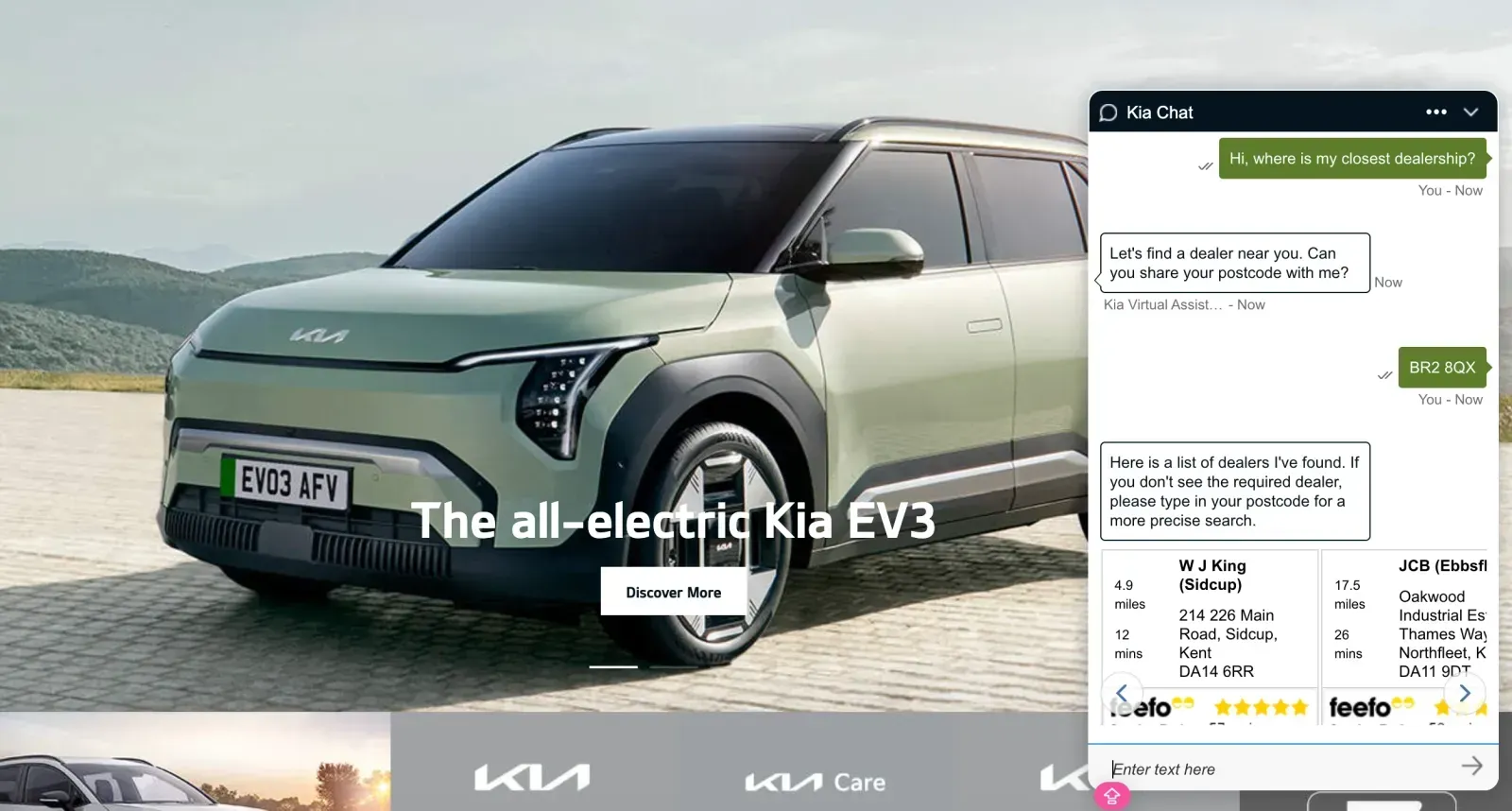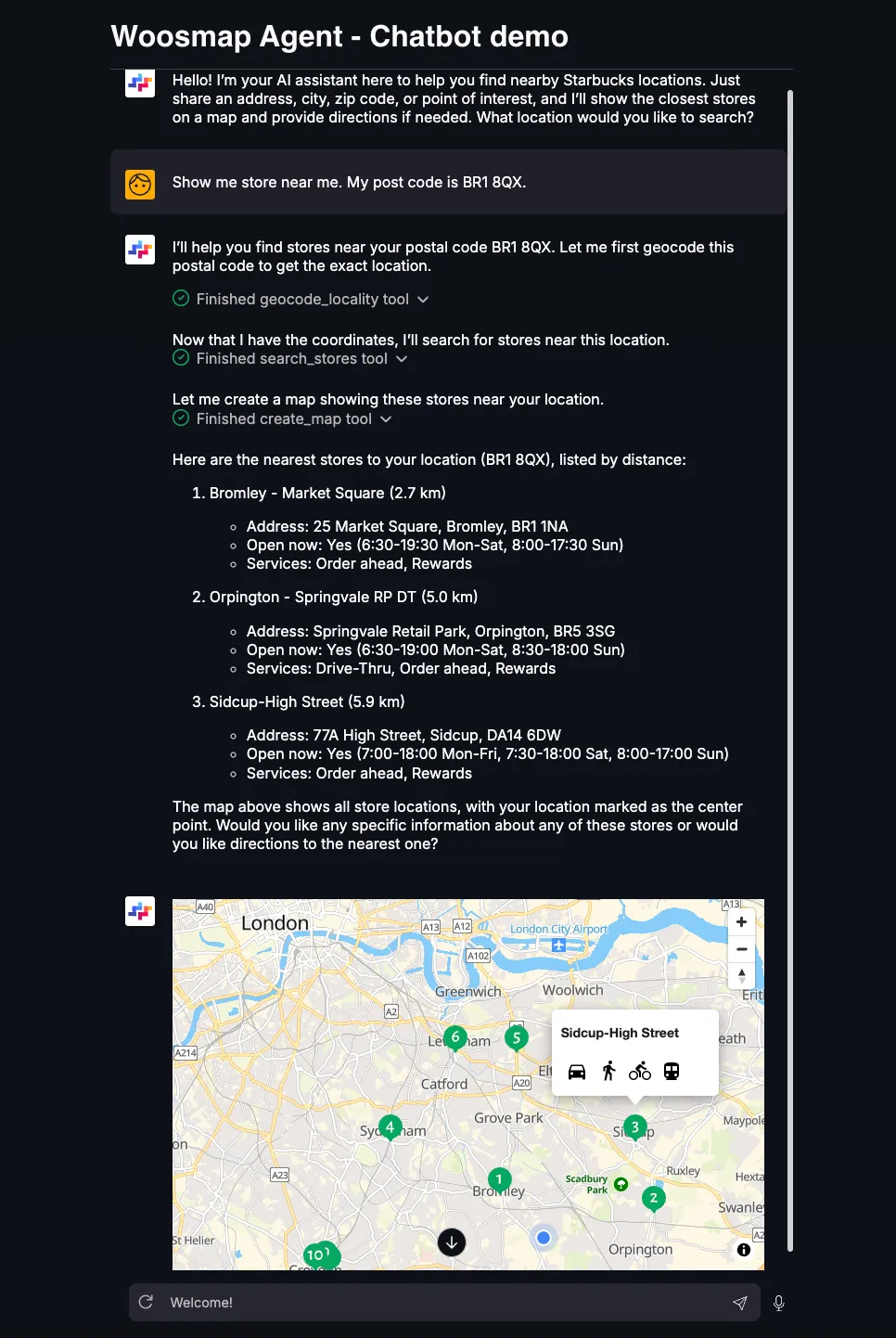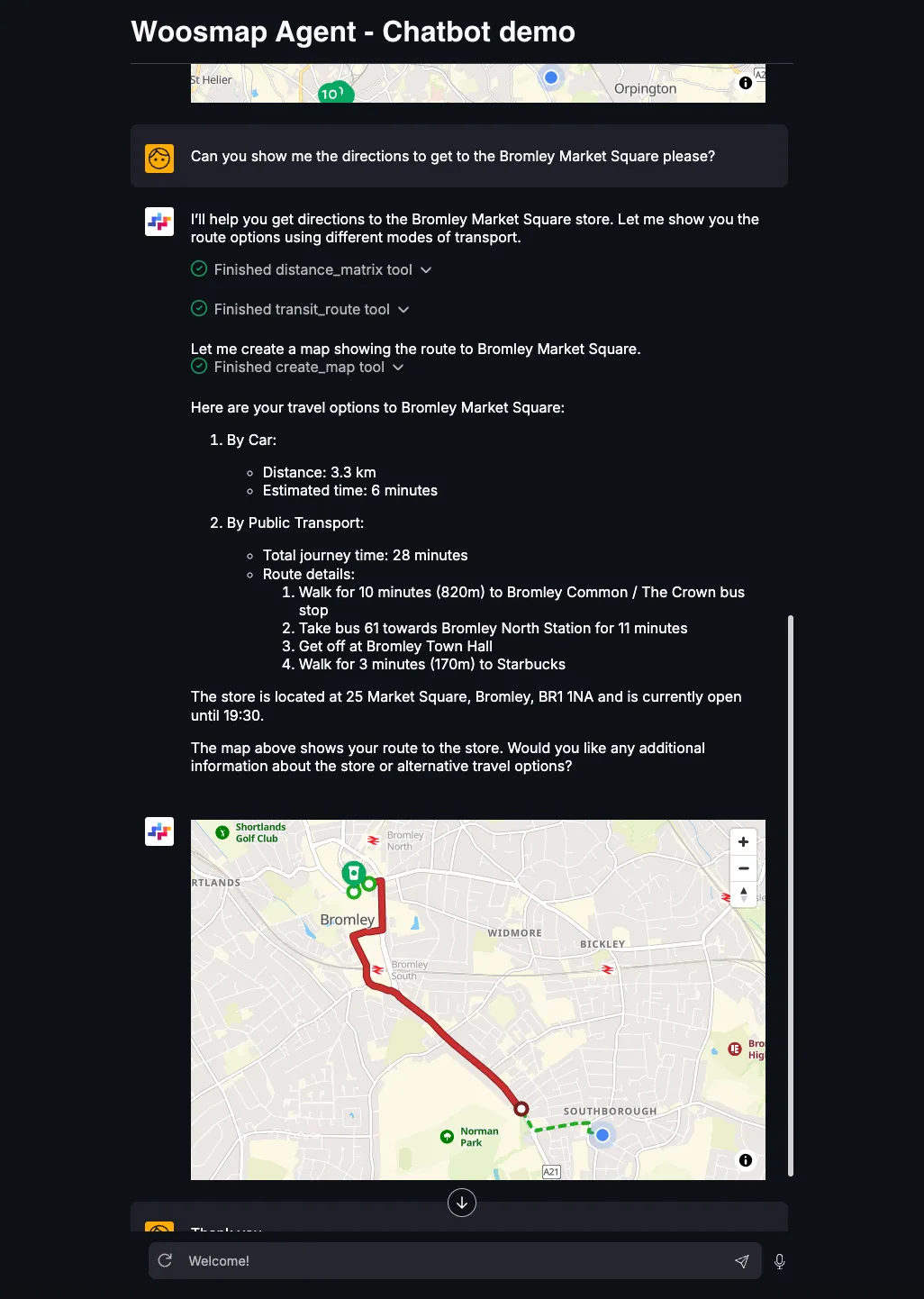What If Your Map Could Talk?
KIA UK AI Chatbot Powered by Woosmap
Most of the time, finding somewhere on a map is a process:
You open a map app. You search. You zoom in. You tweak the filters. You scan around. It works — but it’s not exactly quick.
Now imagine if you could just… type your question into a chat, and the map appears, already filtered to what you asked for, already centred on where you are.
You land in Barcelona and say:
“Show me the best tapas bars near my hotel.”
And seconds later, there’s your map. Pins in all the right places. No extra steps.
From Chat to Map, Without the Extra Work
With Woosmap, developers can build intelligent chat experiences, such as chatbots and virtual assistants, that turn user questions into fully interactive maps instantly.
The chatbot leverages artificial intelligence to understand user questions in natural language, factors in their location data, and generates a map directly within the conversation, enhancing the user’s experience.
It’s not just nearby places; it's nearby places that fit exactly what the user has asked for, based on deep learning and data insights.
Dog-friendly cafés by the river, hotels within a short walk of the conference venue, and charging points along tomorrow’s route are all identified by the chatbot using intelligent data to generate precise recommendations. And because the interactive map is embedded within the chat conversation, users don’t have to leave the chatbot or virtual assistant to access a clear visual. This leads to less friction, more user engagement, and a smoother path from question to action.
When the Chatbot Starts Thinking Ahead
Better yet, combining this feature with groundbreaking AI and artificial intelligence chatbots powered by generative AI deepens the interactive capabilities.
These advanced virtual assistants understand natural language, don’t just give static responses but can dynamically create content such as tailored itineraries, learn from user interactions, and generate location recommendations infused with the user’s specific preferences.
For example, an AI-powered assistant can automatically suggest places open at unusual hours or even pre-schedule visits for events, enhancing the user experience.
Source: IBM
Why It Works So Well
It’s simple: users find it easier to ask a question to a chatbot than to run a traditional search. The conversation with the virtual assistant becomes the search box, and the interactive map is the answer.
Woosmap makes it possible by combining:
- Location detection — to know where the user is, or to pinpoint the place they’re referring to using real-time data.
- Search tools — that pull in only the most relevant places, filtered to the user’s needs through intelligent algorithms.
- Dynamic map rendering — so the final result isn’t just a list of names, but a clear, clickable, interactive map with enhanced capabilities.
This innovative technology allows for unmatched conversational AI by integrating deep learning systems that improve over time through user interactions. As users ask location-related queries, the chatbot learns from their questions and preferences, generating optimized answers and boosting personalization for future inquiries.
Source: DeepAI
Because the system is dynamic, the map app can adapt in real time — if the user changes their criteria (“actually, make that vegan-friendly” or “can we look at places open past midnight?”), the new version appears instantly, ensuring data accuracy and enhancing user privacy.
Where This Changes The Game
This kind of conversational mapping is a natural fit for:
Travel & tourism — Enhance the user experience by providing access to tailored travel information without requiring users to learn a new app interface. “Where’s the nearest viewpoint I can walk to in under 20 minutes?”
Retail & e-commerce — Help shoppers find your stores, pickup points, or delivery coverage areas in seconds through intelligent chat queries. “Show me all pickup points within 5km of my office.”
Transport & mobility — Allow riders to see stops, stations, or vehicle locations on a live map just by asking the virtual assistant. “Where’s the nearest bike I can unlock right now?”
Real estate — Show properties that match a buyer’s exact requirements, mapped out in real time through the chatbot’s capabilities. “Find me two-bed flats within a 10-minute walk of a primary school and a park.”
Events & hospitality — Guide attendees to venues, parking, or partner restaurants around an event location with real-time map insights. “Where can I eat dinner after the concert that’s still open at 11pm?”
Conversational mapping also has untapped potential in IoT (Internet of Things) integration. Chatbots equipped with IoT connectivity can dynamically query real-time data fed from devices such as smart thermostats, traffic signals, or public transport systems. For instance, a query for parking could also reveal available spaces in real-time near your current or projected location, enhancing security and privacy.
Source: IBM
A Real-World Example
Take a hotel chain that wants to enhance the guest experience. Instead of giving travellers a paper map or a static “things to do” list, the hotel integrates a Woosmap-powered chatbot widget into their booking confirmation emails.
Guests type:
“What’s a good seafood place near the hotel?”
Within seconds, the chatbot generates an interactive map highlighting options within a short walk — complete with opening hours and walking directions, improving user satisfaction.
Guests can also leverage multimodal AI systems, where a chatbot listens to voice requests and responds through text while displaying images or maps. This virtual assistant capability enhances accessibility and reduces tedious typing for some users, especially when multitasking.
Source: Google Gemini
The guest starts their trip with immediate, personalized recommendations, and the hotel positions itself as a supportive, intelligent service, making the experience memorable.
Performance & Business Benefits
This approach isn’t just beneficial for users — it has a measurable business impact:
- Faster decisions: Less time searching through apps means users act sooner, whether it’s booking, visiting, or buying.
- Higher engagement: Interactive maps and chatbot conversations are more compelling than static lists, keeping people on your site or app for longer.
- Better conversions: Personalized, relevant responses reduce drop-off from irrelevant options, boosting conversion rates.
- Brand differentiation: A smooth, instant experience with intelligent assistants stands out in crowded markets.
User Experience Enhancements
The magic is in the details. A conversational map can also include:
- Live opening hours so users aren’t sent to a closed location.
- Walking, cycling, or driving times from their exact position, based on real-time data.
- Accessibility details like step-free access or wheelchair-friendly venues.
- Shareable links so results can be passed to friends or colleagues instantly via phone or other apps.
- Filters for “open late,” “pet-friendly,” “free Wi-Fi,” or any other relevant criteria based on user preferences.
Additional emerging technologies such as agentic AI trends can be embedded into conversational mapping systems. This involves empowering the chatbot to make proactive suggestions without the user initiating the query — for example, notifying a tourist of a seasonal event happening nearby, or generating instant insights based on user data.
Each of these adds a layer of usefulness that makes the map more than just a visual — it becomes a decision-making tool enhanced by artificial intelligence and user-centric design.
See It For Yourself
We’ve put together a simple demo. You ask a question, it answers with a tailored map.
No switching tabs, no digging through results. Just a quick, clean, visual answer.
Try the demo and see how effortless location discovery can be.
Once you’ve seen it in action, imagine what you could do for your users.
You can create your own conversational mapping experience — one that understands your audience, reflects your brand, and delivers instant, personalised maps right inside the chat.
Get in touch with our team to explore how to build your own. We’ll walk you through ideas, integrations, and possibilities so you can start delivering location experiences your users will love.


